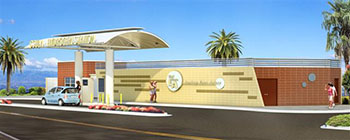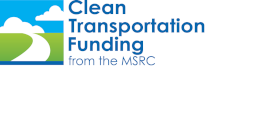 Nearly a decade in the making, the new sustainable hydrogen research facility at California State University, Los Angeles (CSULA) is weeks away from being completed. What started out as a dream of one visionary faculty member to "drive on sunshine," is now becoming a reality.
Nearly a decade in the making, the new sustainable hydrogen research facility at California State University, Los Angeles (CSULA) is weeks away from being completed. What started out as a dream of one visionary faculty member to "drive on sunshine," is now becoming a reality.
The project was launched by the late Associate Professor James Ettaro, who taught in CSULA's Technology Department. In 1995 Dr. Ettaro had written his Ph.D. dissertation on hydrogen power systems, inspiring his vision to create the department's Power, Energy and Transportation Program. The program enabled Dr. Ettaro to advance his research by studying alternative fuels and by engaging his students who came from many different disciplines.
Dr. Ettaro developed a relationship with CSULA alumnus Gary Dixon at the South Coast Air Quality Management District (AQMD), who alerted him to the availability of AQMD funding for other projects, such as wind turbines and solar panels. John Johns, the University's Senior Director of Development for Major Projects collaborated with Dr. Ettaro on these innovative projects, but also helped encourage the professor's ambitious goal of creating a new fuel for transportation, or, as he liked to call it, "driving on sunshine." CSULA received its initial funding to build a sustainable hydrogen facility from AQMD.
"This was like getting the Good Housekeeping Seal of Approval for the project because the agency is so well-respected for its science and expertise in reducing air pollution and advancing new technology," said John. Dr. Ettaro's vision for the facility was not only to generate sustainably-produced hydrogen, but also to not rely on "off the shelf" technology, and instead use technology that was state-of-the-art.
Tragically, Dr. Ettaro passed away in 2005. His faculty mentor Professor Virgil Seaman and other colleagues committed to building the station to honor Dr. Ettaro's work and legacy at CSULA, as well as to benefit the campus' academic offerings and reputation, and to help move the technology forward for the industry. After a long search, Associate Professor David Blekhman was hired to lead the Power, Energy and Transportation Program, and has been instrumental in helping move the hydrogen fueling facility and other projects forward.
1 In 2007, at a critical time in the project's development, the MSRC contributed $250,000 in Clean Transportation Funding toward the total estimated project budget of $4.6 million. Other funding then followed, including a large grant from the California Air Resources Board, as well as a congressional appropriation and funding from the Ahmanson Foundation and the Automobile Club of Southern California.
"We live and work in the most heavily polluted corridor in California. This facility will enable our students to help solve or mitigate serious problems caused by air pollution and the use of petroleum in their communities and neighborhoods," said John. "Many of our students come from areas along the 710 and 10 Freeways, which is a virtual smog belt. This facility also will generate valuable new knowledge and data for the world regarding how to make non-polluting, sustainably produced hydrogen a viable alternative fuel that non-polluting, sustainably produced hydrogen a viable alternative fuel that will help reduce air pollution."
According to John, CSULA is striving to be an incubator for green jobs. He noted that two years ago, 12 professors with significant research interests in the science, or the public policy aspects of sustainability, formed the University's Center for Energy and Sustainability, which was funded by an initial $5 million grant from the National Science Foundation.
Trying to advance hydrogen as a sustainable alternative fuel is not without its challenges since the technology for producing and dispensing the fuel for transportation applications is largely in its infancy. Currently, the facility can fuel approximately 15 cars per day.
"We're not trying to be the corner gas station. Our purpose is to research, test and teach the commercial viability of hydrogen. We [the industry] are in a critical phase - we need to improve the production, storage, and dispensing capabilities of hydrogen facilities, and develop industry standards for fuel purity and weights and measures. All of these efforts will help expand the popularity of hydrogen fuel cell vehicles in Southern California. In fact, prototypes have advanced to the point that hydrogen vehicles are now very close in performance to internal combustion vehicles."
John also points to the facility's prime location, which is close to several major freeways (10, 710, 110, 5, 210, 105 and 605), and just three miles from Downtown Los Angeles. He mentioned that many of the existing hydrogen stations in the region are located in the West L.A. area along the 405 freeway, which makes CSULA's hydrogen facility a valuable new resource for East Los Angeles.
John emphasized the importance of the University's funding partnerships in building the hydrogen facility, especially the support of the MSRC, in ensuring such a large, technically advanced project is successful.
"This project could never have happened without our funding partners, including the MSRC. Having an agency like the MSRC, with the main goal of reducing air pollution, is a Godsend. Historically, Southern California, through the AQMD and MSRC, has effectively provided the region, and nation, with the leadership and scientific knowledge needed to help reduce the toxic effects of air pollution."
John added, "as the MSRC's mission is to reduce air pollution, most of the U.S. is bereft of the leadership and funding that the MSRC provides, leaving some areas of the country decades behind Southern California in reducing air pollution. The MSRC professional staff has been very accommodating when timeline issues presented themselves during the facility's construction. Their expertise and interest in our work has fostered a partnership based on shared knowledge and mutual goals."
The hydrogen facility is in the commissioning phase. CSULA is currently planning a grand opening to commemorate the facility, which will showcase the innovative work of the faculty and students, as well as the capabilities of the station itself.
